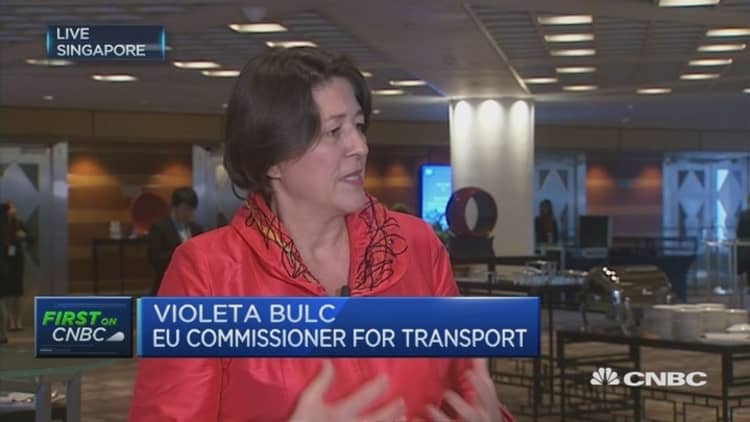Policymakers and industry experts are busy swapping ideas at this year's annual aviation trade show in Singapore, with some telling CNBC that cooperation and partnerships could lead to further growth in the sector.
Violeta Bulc, the transport commissioner for the European Union, told CNBC on the fringes of the Singapore Airshow Aviation Leadership Summit, that a lot of "time and effort" had been dedicated to coming up with a "very comprehensive aviation strategy."
She said the two core motivations behind the Union's approach are to boost efficiency in European skies and for the bloc to tie up with different regions around the world, particularly growing markets.
Meanwhile, IATA's (International Air Transport Association) Director General and CEO, Tony Tyler, echoed the importance of partnerships within the aviation industry.
"By 2034, global demand will reach 7 billion passengers, but that demand can only be accommodated through a working together approach by all aviation stakeholders including governments," he said at the event.
Building bridges in the Gulf

Economic and political motivations often stand in the way of widespread, global partnerships. One example reportedly being Gulf carriers such as Emirates, Etihad Airways, and Qatar Airways.
Last year, reports stated, they were accused of receiving heavy subsidies from their governments, which allowed them to undercut their U.S. competitors by providing cheaper air tickets. The carriers denied the allegations at the time.
However, Bulc was optimistic about future partnerships between the EU and the Gulf Cooperation Council, the regional political and economic union for Gulf states except Iraq.
"First of all, we have to respect the growth they were able to generate in Gulf countries," she said.
"Of course, we are very much interested in open negotiation for comprehensive bilateral agreements [with the GCC], within which we will settle all possible disagreements."
She believes that there is a "mutual agreement" that could allow the two regions to grow together, adding that she was very positive about prosperity of future negotiations.
A lucrative prospect in the Middle East will certainly be Iran, which returned to the international market earlier this year when U.S.-led sanctions on the country were lifted.
Iran is reportedly investing $27 billion in an airline fleet capable of taking on the likes of Emirates, Etihad, and Qatar. A Reuters report last month stated that Iran ordered dozens of long-distance European jets in January.
But, European negotiations with Iran have yet to begin, said Bulc.
"At this stage, we submitted to the European Council the proposal for negotiations and we are hoping to get a very dynamic open mandate and we hope this year, all the negotiations will start."
Looking East
Bulc has also set her sights on developing more bilateral agreements with growing regions around the world, including Association of Southeast Asian Nation (ASEAN) countries.
Rajiv Biswas, chief economist for Asia Pacific at IHS Global Insight said in a note last Friday the aviation industry in the region is set for "buoyant growth with the region's commercial air transport sales forecast to grow at 9.2 [percent] per year in nominal USD terms over 2016-2020."
ASEAN countries such as the Philippines, Malaysia, Indonesia, and Vietnam will see high growth rates in air transport industry sales while China and India will be key drivers over the medium term, said Biswas.



